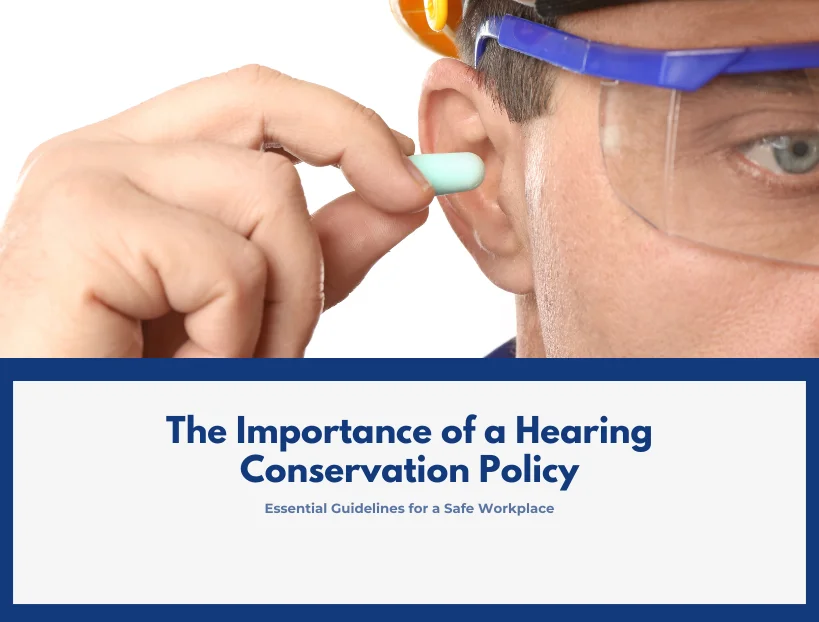Employers should aim to have a comprehensive risk control and safety program. If you’re starting from scratch, check out our blog article, Safety Made Simple. A critical component of any effective safety program is a Hearing Conservation Policy.
The Importance of a Hearing Conservation Policy
Introduction
Every business has a responsibility to protect its workforce, but one of the most underestimated hazards is also one of the most damaging: occupational noise. According to OSHA, more than 22 million workers in the United States are exposed to hazardous noise levels each year. Even more concerning, hearing loss is the third most common chronic physical condition—outpacing diabetes and cancer.
The consequences are not only personal, affecting communication, mental health, and quality of life, but also financial. U.S. businesses spend an estimated $242 million annually on workers’ compensation for hearing loss.
A well-structured Hearing Conservation Policy is all about prevention. OSHA mandates that employers take protective measures when noise exposure reaches a time-weighted average (TWA) of 85 decibels (dBA) over an 8-hour workday. This article explains why your business needs a policy, what it should include, and how you can get started immediately—even for free.
Why Hearing Conservation Matters
Noise-induced hearing loss is one of the most common occupational illnesses. It can happen gradually and go unnoticed until the damage is permanent. A strong policy doesn’t just help you stay compliant—it helps protect workers’ long-term health and productivity.
What Is a Hearing Conservation Policy?
This policy acts as a strategic framework for:
- Identifying noise hazards
- Measuring exposure
- Providing hearing protection
- Delivering employee training
- Conducting medical surveillance
- Meeting OSHA’s regulatory standard (29 CFR 1910.95)
Key Elements of a Hearing Conservation Policy
Your policy should include:
1. General Requirements
- Identify employees exposed to high noise levels.
- Calibrate measurement instruments.
- Record results and provide workers with access.
2. Hearing Tests/Exposure Monitoring
- Conduct baseline and annual audiograms.
- Repeat monitoring after equipment or process changes.
3. Employee Notification
- Notify workers of noise levels and test results.
4. Engineering Controls
- Purchase quieter equipment.
- Add enclosures or damping to reduce noise at the source.
5. Administrative Controls
- Rotate workers or limit time spent in high-noise zones.
6. Audiometric Testing
- Conducted annually.
- Performed by certified or trained professionals.
7. Audiometric Evaluation
- Compare annual results to baseline audiograms.
- Detect and respond to Standard Threshold Shifts (STS).
8. Hearing Protection Equipment
- Provide hearing protection at no cost.
- Ensure proper fit and use.
9. Training
- Train affected employees annually.
- Cover effects of noise, hearing protection, and test procedures.
10. Recordkeeping and Evaluation
- Maintain audiometric records for at least two years.
- Regularly evaluate the effectiveness of your program.
Draft a Comprehensive Policy
Assign this task to someone experienced in drafting safety policies. While templates exist online, many are generic and require extensive customization to meet OSHA standards.
If you have a paid account, Smarter Risk’s Policy Builder makes it easy. After you complete your risk assessment, our app builds a tailored policy based on your responses. You can download it in Word format and make edits if needed.
Want to get started for free? (No credit card required!) Click HERE to begin.
Helpful Resources
Here are three authoritative links to support your efforts:
Frequently Asked Questions
What is the OSHA limit for noise exposure?
85 dBA over 8 hours is the action level requiring hearing protection.
How often should audiometric testing be done?
After the baseline, annual testing is required. New noise sources also trigger retesting.
Are employers required to pay for hearing protection?
Yes. OSHA requires hearing protectors to be provided at no cost to employees.
How can I measure workplace noise levels?
Use a calibrated sound level meter or dosimeter. Consider hiring an industrial hygienist.
Is training on hearing conservation mandatory?
Yes. All affected employees must receive annual training.
Can hearing loss from noise be reversed?
No. Noise-induced hearing loss is permanent—but it is 100% preventable.
Conclusion
Having a strong policy in place helps you avoid OSHA fines, reduce the risk of costly claims, and show your team you’re serious about their safety. It’s one of the simplest, most effective ways to protect your people and your bottom line.
✅ Ready to Take Action?
Start your FREE risk assessment and build your policy today at Smarter Risk.
